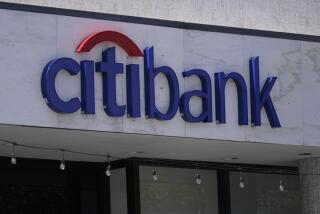Plan Spurs Fear Pacoima May Lose Only Bank
PACOIMA — At first glance, there’s nothing special about the TransWorld Bank branch here on Van Nuys Boulevard. It has a broken sign and no ATM, but otherwise, it could be any bank on any commercial strip in the city.
Yet TransWorld has the distinction of being the only bank in Pacoima. Typical of many lower-income communities, Pacoima, with a population of 81,000, has a wealth of check-cashing outlets and pawnshops but no banks, save this one.
So Glendale Federal Bank’s recent announcement that it would acquire all 12 TransWorld branches, including Pacoima’s, has touched a nerve here.
Fearful that the branch might be shut down, and seizing the opportunity to spotlight Glendale Federal’s lending record to minorities, a group of anti-poverty activists are protesting the acquisition and have requested a hearing before the federal Office of Thrift Supervision, the agency that must approve the deal.
“I don’t know too many people who can say, ‘I live in a community that doesn’t have a bank,’ ” said Jose De Sosa, vice president of the California state conference of the NAACP, which has joined the protest. But “once the merger takes place, in a year or so, what’s to prevent [Glendale Federal] from closing the branch?”
Glendale Federal, which has said it has no plans to close the branch, calls the protests bombastic and misleading. But the dearth of banks in Pacoima has long been a sore spot for residents.
“Some communities have three banks on a block. I mean, come on!” said resident Harry Rose, who manages a grocery store called La Placita. “This community needs the services that every other community has.”
Pacoima is about 77% Latino and 13% African American. About one-third of its residents fall below the federal poverty line, according to Los Angeles County projections based on the 1990 U.S. Census.
That makes Pacoima especially vulnerable to a bank closure, said Gary Dymski, a professor of economics at UC Riverside. Banks tend to flee poor minority communities, opting instead to “cluster” branches in more affluent markets, he said.
The TransWorld branch in Pacoima was established in the 1950s, when the bank was founded. Throughout its history, TransWorld focused on lending to small businesses, and to this day it does not offer home loans, said TransWorld Executive Vice President John Marquis.
It was this small-business lending portfolio that attracted the offer from Glendale Federal, which announced in November that it had agreed to acquire TransWorld--with assets of $375.3 million--for $63 million.
There are other bank branches in the areas around Pacoima: San Fernando has TransWorld, Wells Fargo and Bank of America branches, and Arleta has a new B of A branch in a grocery store.
And Pacoima does have other ATMs located in convenience stores--about a half dozen by most estimates.
But local activists have long argued that the area is underserved by banks and ATMs relative to its population.
Those protesting the merger, including the Greenlining Institute, the California Reinvestment Committee, the Hispanic Chambers of Commerce, the Black Business Assn. and others, want Glendale Federal to guarantee it won’t close the bank and to further pledge to add ATMs and improve its record of lending to minorities.
For its part, Glendale Federal says it has no plans to close the branch and plans to add ATMs, provided they are deemed safe at that location.
Glendale Federal even has won tentative approval for the acquisition from such local community activists as Ed Kussman, president of the Pacoima Chamber of Commerce, and City Councilman Richard Alarcon.
After meeting with Glendale Federal Chairman and CEO Stephen Trafton last week, Alarcon said his “initial impression” is that “there is every reason to believe Pacoima can gain from the sale of TransWorld Bank to Glendale Federal.”
But Alan Fisher, executive director of the California Reinvestment Committee, responds that Glendale Federal’s assurances are “not something that gives me surety that in two years they would hold to it.”
Fisher’s group wants Glendale Federal officials to sign an agreement committing the bank to keeping the branch open, adding ATMs and targeting lending to low-income borrowers, among other requests.
Fisher’s account of the dispute differs from the bank’s. He said the bank stalled on a request to meet; Glendale Federal said it offered to meet with the group this month.
Glendale Federal chief Trafton says he is “baffled” by the criticism. “We proposed to be the only major bank in Pacoima,” Trafton said. “I mean, they don’t want us there?”
Trafton accuses out-of-town critics of using the merger to get attention, a charge partly confirmed by Robert Gnaizda, general counsel for the Greenlining Institute.
Acquisitions offer advocates a rare chance to draw public and governmental attention to bank lending practices, Gnaizda said. “Historically, mergers have been the time when greatest scrutiny has been applied to financial institutions,” he said.
The Greenlining Institute has long been concerned with what Gnaizda says is Glendale Federal’s scant minority-lending record, but until now the group has had no chance to air these views, he said.
The institute says the bank made only 78 home loans to African Americans in 1995. But Glendale Federal, which has 153 branches, defends its lending record. Proportionately, its home loans to minorities--27% of the total--are on par with several other major thrifts, said Trafton.
The number of loans is low because the bank hasn’t been lending much in the wake of severe financial problems in the early 1990s. And more recently, the bank has been concentrating on small-business lending, not home loans, said Glendale Federal spokesman Ken Preston.
The Office of Thrift Supervision will hear arguments from Glendale Federal’s critics during a closed hearing in Los Angeles on Feb. 6. The merger is still to be approved by TransWorld shareholders.
The present flap is unlikely to hurt Glendale Federal materially, said Gary Gordon, a bank analyst with the PaineWebber brokerage in New York. Such protests surrounding mergers “are very, very common,” he said. “It’s also common for them to disappear entirely.”
However, the dispute could prove embarrassing for Glendale Federal, which is conducting an aggressive marketing campaign to portray itself as a grass-roots bank sensitive to community needs.
The issue was not a burning one on the streets of downtown Pacoima last week. Few people interviewed had heard about the merger. Most seemed resigned to traveling a little farther to find an ATM.
Greg Ramos, who owns G & G Auto Parts next door to the bank, said with a shrug that he might make more sales if his customers had easier access to an ATM, but added that he really doesn’t give it much thought. Most people get cash from check-cashing outlets, he said.
There are several such outlets doing brisk business in the vicinity of TransWorld, reflecting a cash-driven local economy typical of many low-income L.A. neighborhoods.
As at most businesses in the area, nearly all the sales at the La Placita grocery store are in cash, said Rose, the manager. Less than 10% of La Placita’s customers write checks, and the store does not accept credit cards, he said.
In such areas, it is common for people not to have bank accounts at all. Nationwide, according to the Federal Reserve Board, about 13% of families, most of them poor, don’t keep bank accounts.
Like Glendale Federal’s critics, Dymski, the Riverside professor, believes that more banks in low-income neighborhoods might boost savings among the poor.
But John Caskey, a professor of economics at Swarthmore College in Pennsylvania, said the reason banks shrink from putting branches in low-income communities is the obvious one: People who live there have less money, and “banks go where there is a lot of business,” he said.
Simply ensuring that banks locate in poor areas won’t solve the deeper issues of income distribution and lack of consumer education that created the disparity in the first place, he said. Even Caskey agrees that poor communities need banks for less tangible reasons, though. Such branches may indirectly affect how much banks lend to low-income and minority borrowers.
And their symbolic import is keenly felt by local residents and business people. Said Rose, the store manager: “When banks leave, a community dies.
“In the old Western towns, what did you have? You always had a saloon, a guy who cuts hair, a market and a bank. That’s a community.”
More to Read
Inside the business of entertainment
The Wide Shot brings you news, analysis and insights on everything from streaming wars to production — and what it all means for the future.
You may occasionally receive promotional content from the Los Angeles Times.










